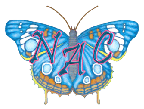PAIRPOINT
Vol. 3 Issue 8
The Pairpoint Manufacturing Company was located in New Bedford, Massachusetts. It was built in 1890 and was initially a metalworks company whose main product was coffin fittings. It was
named after its first superintendent, Thomas J. Pairpoint. He was considered one of the greatest silver designers in England and America. It became one of the largest manufacturers of silverplated
ware in the United States. The Mt. Washington Glassworks, who made many types of glassware of high quality, was next door. In 1894, the two companies merged. Their products were glass, silver
plated pieces, and lamps. They also produced reverse-painted glass shades and molded shades called "puffies" until the 1930's. There were three main types of shades, all blown. The "puffies" were
blown out reverse-painted shades with floral designs; ribbed, also reverse-painted; and scenic, reverse-painted with scenes of land or seascapes. Some of the scenic shades were signed by the artist.
Every shade was stamped with the "Pairpoint Corp.", Patent Pending, Patented July 9, 1907, or Patent Applied For. The bases were usually made of bronze, copper, brass, silver, or wood and were
always signed.
There were various and interesting shapes in their heavily cut-glass wares. They made footed pieces such as footed spooners, and celeries. Flower holders, glove boxes, bowls, ice cream trays, jugs,
catsup bottles, relish trays, cheese plates with covers, and center vases were also produced. Several of their patterns included fan accents, stars, and cross-hatched diamonds.
Due to their making of only fancy, handmade wares, sales dropped seriously, during the depression. Also, tastes changed, as well as styles, which caused their pieces to be in less demand. The com-
pany never fully recovered, therefore, part of the buildings and equipment were sold in 1938. In 1939, under the direction of Robert Gundersen, the company was reorganized and again began
producing hand-blown glassware. The silver department was taken over by Isaac Babbit. Robert Gundersen, along with Isaac Babbit established the Gundersen Glassworks, Inc. Sales again began
to slow after WWII, so it became necessary for the company to again reorganize. The Gundersen-Pairpoint Glassworks was then formed. Cut, engraved glass was then reintroduced. In 1957, the
company was moved to East Wareham, Massachusetts and was closed a year later. In 1970, the company built facilities in Sagamore, under the direction of the sales manager for the company
in the 1950's, Robert Bryden. Shortly after reopening, Pairpoint began producing "Peachblow". It was made right away as a way to fund the new company. It had been made intermittently from
1970-1988.
In 1974, the company began producing lead glass cup plates for fund-raisers for many churches and organizations. Some have become very collectible due to the fact that they are limited editions.
PairPoint Glassworks is still in production today and is open to the public for viewing the glassblowers at work.
MARK:
The Pairpoint mark is a diamond with a "P" in the center and two lines above and below the "P".
COUNTERFEITING:
The rarity and complexity of a pattern of a piece of cut glass will sometimes catch the eye of a counterfeiter. Be alert to a piece that seems to be priced abnormally high.
There are several ways to test a piece for its authenticity; sometimes more than one test is necessary.
1. Black Light- You will need a long wave black light in an absolutely dark room. Focusing the black light on the cut glass, most old brilliant cut glass will have a lime green color ring. A
counterfeit piece will reflect a pink or purple ring. However, some old pieces do not reflect the yellow-green ring, therefore, you must do all the other tests for counterfeiting.
2. Blank - Counterfeiters use very thick, heavy blanks.
3. Signature - Some counterfeit glass have signatures. However, they may have a smudged appearance and will be hard to read. An original piece of cut glass will have a clear, easily read signature.
4. Wear Marks - Usually there are wear marks on the bottoms of authentic cut glass from usage; counterfeit pieces do not.
5. Diamond Cutter - The major mitres on counterfeit glass show lines from a diamond cutter, which was used after the Brilliant cut glass period. In order to see them, you will need a magnifying
glass and experience in being able to recognize them.
When you purchase cut glass and pay an exceptionally high price test the piece and, always ask for a certificate of authenticity.
To view some examples of Pairpoint glass Pairpoint Glassworks
RESOURCES:
Schroeder's Antique Price Guide, 18th Edition
Kovel's Antiques & Collectibles Price List
Warman's Pattern Glass
Official Price Guide to Glassware - First Edition
Identifying American Brilliant Cut Glass by Bill & Louise Boggess - 3rd Revised Edition
Peachblow Glass, Collector's Identification & Price Guide by Sean and Johanna S. Billings
Pairpoint Glassworks
Collectics
![]()
Questions? Email Us!
SIGN UP HERE!
Get on our FREE Newsletter
Mailing List!

![]()
 |

